Perez v. Brownell
| Perez v. Brownell | |
|---|---|

|
|
| Argued May 1, 1957 Reargued October 28, 1957 Decided March 31, 1958 |
|
| Full case name | Clemente Martinez Perez v. Herbert Brownell Jr., Attorney General |
| Citations | 356 U.S. 44 (more)
78 S. Ct. 568; 2 L. Ed. 2d 603; 1958 U.S. LEXIS 1283
|
| Prior history | Certiorari to the United States Court of Appeals for the Ninth Circuit |
| Holding | |
| Congress has the power to revoke a person's United States citizenship as a result of the voluntary performance of specified actions (such as voting in a foreign election), even in the absence of any intent or desire to lose citizenship. | |
| Court membership | |
|
|
| Case opinions | |
| Majority | Frankfurter, joined by Burton, Clark, Harlan, Brennan |
| Dissent | Warren, joined by Black, Douglas |
| Dissent | Douglas, joined by Black |
| Dissent | Whittaker |
| Laws applied | |
| Nationality Act of 1940; U.S. Const. amend. XIV | |
|
Overruled by
|
|
| Afroyim v. Rusk, 387 U.S. 253 (1967) | |
Perez v. Brownell, 356 U.S. 44 (1958), was a United States Supreme Court case in which the Court affirmed Congress's right to revoke United States citizenship as a result of a citizen's voluntary performance of specified actions, even in the absence of any intent or desire on the person's part to lose citizenship. Specifically, the Supreme Court upheld an act of Congress which provided for revocation of citizenship as a consequence of voting in a foreign election.
The precedent was repudiated nine years later in Afroyim v. Rusk, 387 U.S. 253 (1967), in which the Supreme Court held that the Fourteenth Amendment's Citizenship Clause guaranteed citizens' right to keep their citizenship and overturned the same law that it had upheld in Perez.
Clemente Martinez Perez was born in El Paso, Texas, on March 17, 1909. He resided in the United States until 1919 or 1920, when his parents took him to Mexico. In 1928, he was informed that he had been born in the state of Texas.
During World War II, he applied for admission and was admitted into the United States as a Mexican alien railroad worker. His application for such entry contained his recitation that he was a native-born citizen of Mexico. By 1947, however, Perez had returned to Mexico, and in that year, he applied for admission to the United States as a citizen of the United States. Upon his arrival, he was charged with failing to register under the Selective Service Laws of the United States during the war.
...
Wikipedia
